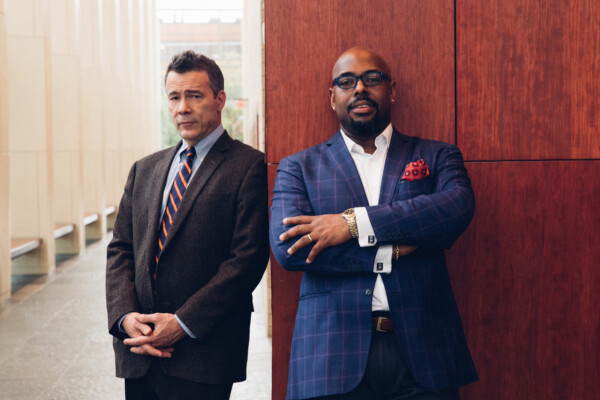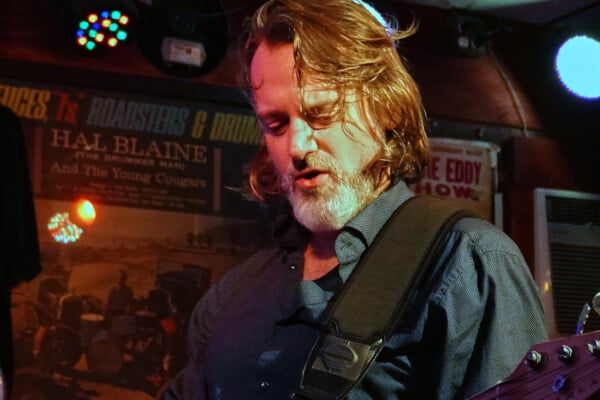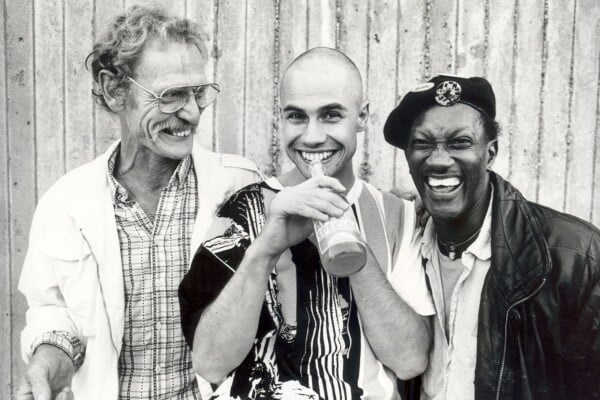Euphonic Audio: An Interview with Larry Ullman
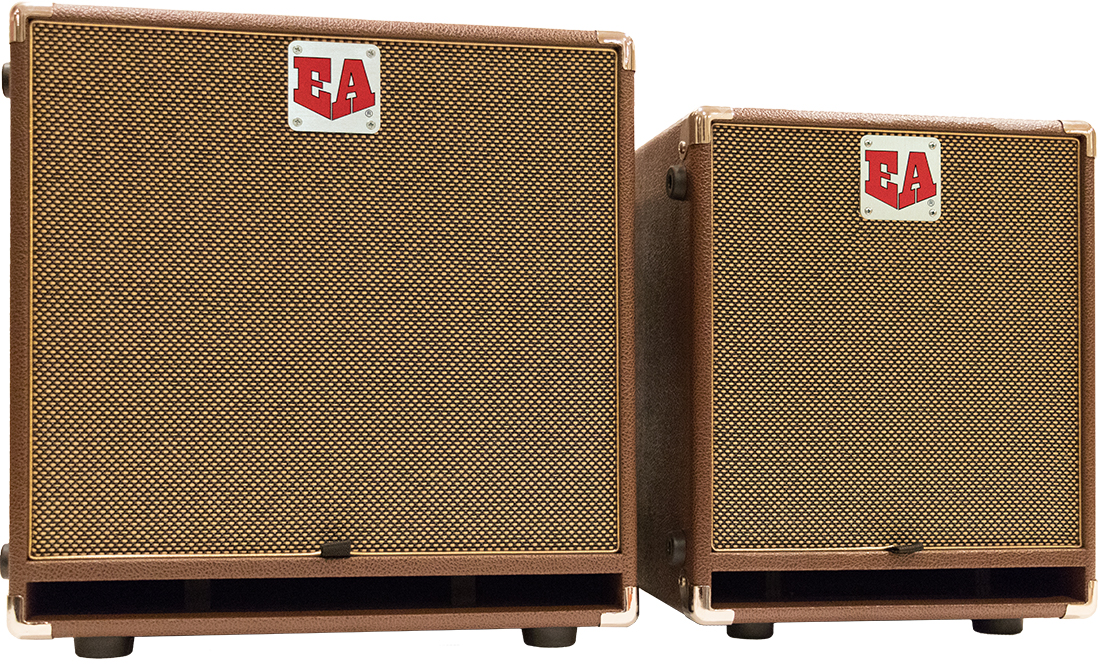
Euphonic Audio is a bass amp company that focuses on creating pristine amplification in compact packages. That makes total sense when you consider the company, founded in 1981, began with Larry Ullman and John Dong collaborating to create hi-fi home speaker systems. The duo tirelessly studied the best high-end audio products to figure out the physics that made them work. Shifting to making bass cabinets in 1995, they added amp designer Gary Gibilisco to begin offering their own amplifiers, as well. Ever since they’ve been using science to help bassists create art.
EA currently offers a handful of amps featuring Class D power sections, keeping their weight between four and nine pounds. Despite their diminutive size, they’re packed with features for maximum versatility and tweak-ability. Their line of cabinets also benefit from their hi-fi experience with transmission line designs, neodymium magnets, and whizzer cones to help reproduce all the nuances of your playing. Be sure to check out their website to get the low down on those concepts.
We had a great conversation with Larry Ullman, whose work as a pro bassist was the spark to shift EA into bass gear. He gave us an insider’s look at the industry and the creation of a company as well as their design philosophies and how speaker size affects your output.
How did the Doubler come about?
To my knowledge, we were the first to market a micro amp, which was the original iAmp Micro 300. We built that to be as light as we could possibly make it. It was around 2 pounds and 300 watts. Guys were complaining that they were pulling them off the top of their amp with their cord because they were so light. People started suggesting putting toroidal transformers on top of them to weigh them down. [laughs] Very shortly thereafter we came out with the iAmp Micro, which was 500 watts. It was really successful and swelled all the way up to 2 1/4 pounds or so.

Mike Arnopol got a hold of a Micro and said, “This is really a great idea, but you need to add some features to make it the perfect amp for an upright player that doubles.” We added an XLR input for a condenser microphone with phantom power. Then we added a notch filter and a phase control. The Micro and the Doubler both have a microprocessor that controls which channel is active so you can have channel one, channel two, or both channels. It also senses whether or not there’s an instrument plugged in. If you only have one instrument plugged in and use the channel selector, it will switch between the channels and essentially give you two switchable EQs. That’s controllable via footswitch just like the mute. The idea is that if you’re using a bridge pickup and a magnetic pickup or a bridge pickup and a microphone on your upright, you could control not only the way they blended, but you could control the relative phase between the two pickups. It helps you tune the thickness of your sound, if that makes sense. If you had a feedback issue, then you’d have the notch filter to notch out the feedback.
Are the EQs the same on each channel?
No. The turnover of the mid-range on channel one is 600 hertz and on channel two it’s 800 hertz. The tweaking of the mid-range is different between the two channels.
How did you get into the music industry?
We started in 1981, so it’s going on for 39 years. My partner, John Dong, who I started the company with is an electrical engineer with a master’s in computer engineering. We actually met in college, so we’ve known each other since we were 18. I was into hi-fi and went through amplifiers and all kinds of crazy stuff. I’d call him and tell him, “Hey, I got this great new stereo,” and he’d say, “Again?” He thought I was nuts, which I was. John worked at Grumman Aircraft and got transferred to Princeton University. They didn’t have a lot for him to do, and he had access to the research facilities and libraries at Princeton. He basically said, “These speakers are not that great. I can do better.”
He read over 110 scholarly papers on speaker design and rediscovered the work of a guy named Harry Olson, who did most of the work on enclosures and speakers and Q and all the various parameters that relate to spec’ing a driver. He came up with this radical design for the time, because that was the time of the infinite baffle, which was a closed enclosure.
[The first thing he tackled] was the enclosure. All enclosures have resonances that reinforce certain frequencies because the box starts singing along with the speaker. It becomes a second source of radiation, which is not time-aligned with the primary signal. John said you’re never going to get rid of resonances, but if I make a very highly asymmetrically-braced box, the areas that would radiate are different sizes. That means they would be resonant at different frequencies and be higher up. Ultimately, it would diminish the effect of the box singing.
The second thing he did was come up with a lead foam dampening material. It’s a multi-density material with a layer of heavy foam, a layer of light foam, and a little lead in between. There were a dozen of those inside the box placed on all the different braced areas. So now we’ve handled the box by spreading out the resonances and dampening them the best we can.
The next thing is time alignment, so the woofer was forward of the tweeter. Next was interference between the woofer and the tweeter. He designed a fourth-order crossover, which was also time aligned. The theory at that point was that fourth-order crossovers ring, but he was able to design one that didn’t ring. We also used high-quality capacitors and inductors that were rare.
Then there was the most off the wall thing he did. What he discovered, much to his frustration, was there was a lot of driver to driver variability. Stuff was primarily hand-wound at that time, so you’d get a woofer and it would vary from the given specs. He would order a whole case of tweeters and a whole case of woofers, then sit there to test them and put them into matched sets. Why? Because the variation would change the output of the driver. You could be in the sweet spot while listening to a violin solo, and as the violin goes up in pitch, the image shifts in one direction or the other. That’s from the lack of matched drivers. They don’t track the same.
That was all put into our first product called the Nymph. It got decent reviews all over. We tried to market it and did reasonably well with it. However, as it is with the music industry, the hi-fi industry has a certain amount of ego amongst the designers.
We started making some other models and then around 1985, one of our reps introduced us to a new company that was being formed called Lineage. The president of that was Saul Marantz – yes that Marantz. The electronics designer was John Curl, who is equally as famous in the audio community. He’s one of the most gifted designers ever. In 1987, we stopped developing our own products and started producing a really revolutionary product for them called the Precept One. It got the Product of the Show at Summer CES in 1987. Then October ’87 came and the stock market crashed and there was no money to move the company forward. That was the end of that and the end of us in the audio business.
What happened to get you into the bass world?
We didn’t do much else until 1994 when I met Dan Lakin and Michael Tobias. My kids got old enough that I could start playing again. I began dabbling and became good friends with Dan. He actually sent me the first Lakland to check out. I told him what I was looking for in a five-string and he said, “Oh yeah, Mike Tobias makes this thing called an Eclipse. You’ll really like that.” I bought one and loved it, but I wanted to tweak the neck a little bit. Just for the hell of it, I called Mike and he told me to bring it up. We went to lunch, hung out, and talked about our backgrounds. I told him about what I was doing. Dan also knew that we both had the backgrounds of high-end audio and thought we could do something.
My playing informed what I wanted to make. The thought was first that my rig was too big. It’s killing my back, I’m getting older, and I need something smaller. That being said, my rig does not sound like my studio sound. Why can’t I get my studio sound when I go to a gig? That was the mandate.
My partner John, being a complete lunatic, decided to make the world’s greatest compact bass cabinet. He came up with this thing that became our first bass product called the IL-110. “I” stood for isobaric, and “L” meant line. It was a transmission line cabinet in an isobaric configuration. The trick was to put a 10″ facing outward and an 8″ inside the cabinet. One of the things that we missed is that things in the music industry need to be stupid efficient. That’s the bottom line – you want efficiency. So to make a cab that’s 89dB efficient is like…. no. It sounded wonderful, but it was heavy and you needed a monster amp to push it. We sold a few of those and made a 2×10 version.
Then we went back and rethought the whole thing, and that’s when we came out with the VL-110. It had a 10″ woofer, a 5″ mid-range, and a tweeter that was below the midrange. Everyone asked, “Why did you make it upside down?” Acoustically, they merge better if they’re in that configuration. What did we find? You could hear your fretting technique, your string sounds, and your bass’s sound was consistent from top to bottom. Things weren’t shifting because the crossover was doing its job. A lot of players started to pick up on what we were doing. A lot of players also said, “This ain’t good for the blues.” We showed it at a Summer NAMM Show and got a few Nashville players to start using them, including a guy named Woody Lingle. He bought four of them and still uses them. One of the downfalls for us is that our stuff doesn’t break. [laughs]
Then we came out with the VL-108, which was a super little speaker. We went to the NAMM Show and were showing with Mike Tobias in a hotel room. During the day, we were in Bill Bartolini’s booth as the speakers he was using to show off his pickups. At night, Mike would have some double malt and cigars and people would be playing his stuff through our cabs and a Walter Woods amp. A lot of people get turned onto them in that environment because you could hear what they were doing. That’s when we met Lee Sklar. He and Brian Bromberg showed up at Mike’s hotel room and said, “We’ve heard there’s a cool little speaker here.” They played on it a little and Lee picked up the little 108 and they started hurling it back and forth over the hotel bed like it was a beach ball. We were all cracking up. Lee’s been using our stuff ever since.
At that point, we’d tried to build an alliance with an amp company. Basically, we were selling a ton of amps for Walter Woods, not that he needed our help. He was an independent legend without us, but it was a nice pairing. The problem was that the amps under certain circumstances tended to pop the mid-range. That was problematic. We were also selling a lot of amps for him, so we figured why not sell our own amps?
We developed our own faceplate and control concept with the help of David Inamine and Richard Carpenter, a gifted graphic artist. The first hundred were contracted to Ashdown Engineering for manufacturing but we quickly determined that we should control our own production directly. All iAmps going forward have been designed in house and assembled and extensively tested in New Jersey.
At that point we met Gary Gibilisco, another guy from Princeton University that was also a bass player who had connections in electronics design and mechanical design. He had built a bunch of amps and sub-contracted building amps for people. He joined the company to help make what became our iAmp 600. We had our own MOSFET power section we designed. It also had a tuner in it made by Sabine. Again, the idea was to put a really good DI in it, a really good tuner in it, and you don’t have to carry a bunch of stuff to the gig. It would be in the amp and make life easy.
That amp sold well, but we knew we could do better and get the power up, so we [made an 800-watt version]. They used a Class D power section with a linear power supply. Typically, class D amps (including the ones we make now) have switching power supplies and digital amplifiers. This transition amp had a normal linear power supply – big capacitors and big toroid – but the amp section was digital. It sounded great because if you do a digital amp right, there’s nothing wrong with it. What’s wrong is that power supplies didn’t typically have enough oomph to really dig in. You’d be clipping it all the time and the clip is hard. You can make a case that the difference between a tube amp and a digital amp has a lot to do with the power supply and the clipping characteristics. When you push a tube amp to clip, it self limits, which some people call soft clipping.
So we helped to pioneer that hybrid approach. However, the cost of the transformers quadrupled over the course of a couple of years. It became cost-prohibitive to produce that linear power supply anymore. That’s when ICE [power supplies] started to come into the picture, so we completely redesigned the amp again and went to 1,000-watt ICE modules. The Doubler had come onto the scene so we made a similar topology into an amp called the Pro, which Sklar still uses. That’s the silver-faced amp where I was trying to evoke ’70s hi-fi.
We’ve since come out with a new amp called the iAmp Pro, which is a complete redesign of the user interface. Basically it has the same functionality, but people reported they were intimidated by all the stuff on the front panel. We simplified it and moved it around a little, then switched over to a new ICE module. We modified the power supply extensively to get the energy reserve we need. That amp is nine pounds and sounds like the 800, but is cleaner and faster. It’s just as weighty sounding. We’re currently making that and the Doubler 2, which has a more powerful module from ICE and about 25 improvements over the first one. It swelled way up in weight to four pounds. [laughs] It doesn’t tend to fly off cabinets as much as the other ones.
On speakers, we’ve always made transmission line speakers. Transmission lines are sometimes referred to as magic or a black art or something because there’s no good modeling on how you do a transmission line. Basically what you’re doing is two things. First, you’re trying to get the back wave of the speaker to be in phase with the front wave, so you have to delay it. The length of the transmission line theoretically delays it at appropriate frequencies. Additionally, the mass of air contained in the transmission line and cross-sectional area of the transmission line affects a resistance to the movement of the woofer. If you make it harder to get air through that port, it will dampen the movement of the speaker at extremes. The problem with that is if the cross-sectional area is too big, it doesn’t dampen enough and if it’s too small, you get something called port chuffing where the port whistles. It’s because you’re squishing too much air through it and the turbulence makes a sound. Again, there’s no good modeling of how that works. It’s something you learn through experience and John just has an instinct for it now.
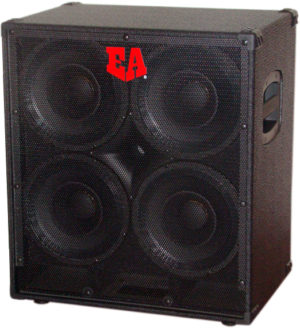 There have been several iterations of that. There was a 4×10 and a bunch of 2x10s. Then there was the NL-210 and 410, which were [neodymiums]. They’re really good. The NL-10 is a super speaker. The VL’s are not neos and are a little heavier. The M-Line Wizzy is the one that upright guys seem to like best. It’s a 12-inch speaker with a whizzer cone. It goes out to maybe 5kHz and doesn’t have a ton of top end. It has two transmission lines that vent out the sides. That extends the bass and smooths out the mid-range, giving a huge stage presence. IF you’re playing a bar gig and there’s no PA help, it just puts out a huge amount of sound for a teeny little speaker.
There have been several iterations of that. There was a 4×10 and a bunch of 2x10s. Then there was the NL-210 and 410, which were [neodymiums]. They’re really good. The NL-10 is a super speaker. The VL’s are not neos and are a little heavier. The M-Line Wizzy is the one that upright guys seem to like best. It’s a 12-inch speaker with a whizzer cone. It goes out to maybe 5kHz and doesn’t have a ton of top end. It has two transmission lines that vent out the sides. That extends the bass and smooths out the mid-range, giving a huge stage presence. IF you’re playing a bar gig and there’s no PA help, it just puts out a huge amount of sound for a teeny little speaker.
Do you think your products are for a certain type of player?
Yeah, a player who gets it. There are people using our speakers for keyboards, electric cellos, violins… I mean, it favors our hi-fi background. It’s a very accurate, relatively flat speaker that’s optimized for MI, meaning it’s stupid efficient.
We’ve had ongoing disagreements with amp designers that insist that there’s no high-frequency energy in a bass. That’s ridiculous. Yeah, the fundamental of an open B is 31 hertz, but there’s a lot going on there. There are overtones. If you’re slapping, that’s a high-frequency event. The rise time of that note has an impact on your sound. The sound of a pick, string windings, your frets, your fretting technique – they all are high-frequency. Guys complain that they can’t use our speakers because you can hear their left hand. I say, “…yeah? Get off the internet and practice.” We used to refer to the midrange as the skill control. The better your fretting hand, the higher you could turn up the midrange control. The idea is that since you have a large sonic spectrum, you can be independent of the kick drum. You have your own space. You’re off the rhythm guitars. It means you’re occupying a larger sonic space in the mix so you can turn down. That’s the whole thing: that’s what we’re about.
What do you think is the biggest thing bassists don’t understand about amplification in general?
Everybody talks about tone, and amplification should not have tone. You want to hear your instrument and your technique and your style and your soul – not the amplifier. The better I could hear myself, the better I could play. To me, that’s what it’s about. I don’t want to be negative or controversial, but I think people’s ears haven’t been trained. If you put it in front of them, I think they get it.
Class D has been pretty maligned by some purists in the past. Do you think that we’re getting over that hurdle?
For sure, the technology is getting better. We still do quite a few things to make it better. The preamp still has to be good, too. It depends on the frequency of the amp, and if it doesn’t have current reserve it won’t sound good.
If you drove a Pinto, would you think that all cars with four wheels are bad? You know, it depends on your experience. If you played a crappy class D amp, [you could think they’re all] bad.
What do you think differentiates good and bad class D amps?
There are so many things that are factors. Everything influences the sound: the topology, the clock, the type of capacitors, the number of capacitors, types of resistors… Everything matters. I can make my amps sound real bad with the right speaker.
Are you still playing?
I haven’t played much lately. I did a bunch of recordings in the late ’90s, which is the last stuff I’ve done. I’ve got a bunch of basses so I’m stocked to the hilt. Mostly what I have is a Tobias and quite a few Sadowsky’s. I had a matched set [of Fenders] at one point with an October ’62 P-bass and an October ’62 Jazz Bass. It doesn’t get much better than that, but my Sadowsky P-bass is the greatest I’ve ever played.
What’s coming up next from Euphonic Audio?
We have a new NL-108, which we’re hoping to put into production that’s 17 pounds of fun. It’s really great for upright and phenomenal for its size. There’s a certain magic to 8’s.
Can you de-mystify speaker sizes for us?
It’s pretty straight-forward. The bigger the driver, the more massive the cone, the harder it is to push around and the less high it goes. For coherence, you want as much out of the driver as you can get. That’s why we went back from three-ways to two-ways. That’s why the Wizzy is a one-speaker design. There’s no crossover or anything screwing it up. Within its bandpass, it’s very coherent. An 8″ sounds better to me because there’s more high-frequency energy coming out of the main driver. Theoretically, if you could make one driver do everything, that would be ideal.

